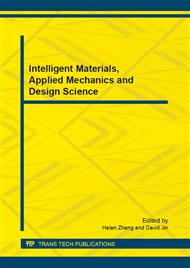[1]
T. R Partridge. Spartina in New Zealand. New Zeal J Bot, 25(1987), 67–75.
Google Scholar
[2]
J.C. Callaway, M.N. Josselyn. The introduction and spread of smooth cordgrass (Spartina alterniflora) in south San Francisco Bay. Estuaries, 15(1992), 18–26.
DOI: 10.2307/1352695
Google Scholar
[3]
C.H. Chung, R.Z. Zhuo, G.W. Xu. Creation of Spartina plantations for reclaiming Dongtai, China, tidal flats and offshore sands. Ecol Eng, 23(2004), 135–50.
DOI: 10.1016/j.ecoleng.2004.07.004
Google Scholar
[4]
C.C. Daehler, D.R. Strong. Status, prediction, and prevention of introduced cordgrass (Spartina spp. ) invasions in Pacific estuaries, USA. Biol Conserv, 78(1996), 51–8.
DOI: 10.1016/0006-3207(96)00017-1
Google Scholar
[5]
C.H. Chung. Forty years of ecological engineering with Spartina plantations in China. Ecol Eng, 27(2007), 49–57.
DOI: 10.1016/j.ecoleng.2005.09.012
Google Scholar
[6]
T.G. Tang, W.J. Zhang. A discussion of ecological engineering benefits of Spartina spp. and its ecological invasion. Engineering Science, 5(2003), 15–20.
Google Scholar
[7]
P. Qin, M. Xie, Y.S. Jiang. Spartina green food ecological engineering. Ecol Eng, 11(1998), 147–56.
Google Scholar
[8]
SW Wan, P Qin, J Liu, et al. The positive and negative effects of exotic Spartina alterniflora in China. Ecological engineering, 35(2009), 444–452.
DOI: 10.1016/j.ecoleng.2008.05.020
Google Scholar
[9]
P. Zuo, C.A. Liu, S.H. Zhao, et al. Distribution of Spartina plantations along the China's coast. Acta oceanologica sinica, 31(2009), 102–111.
Google Scholar
[10]
P. Qin, C.H. Chung. Applied Studies on Spartina. The Oceanic Press, Beijing, pp.61-73, 105–108(1992).
Google Scholar
[11]
R.L. Li, F.C. Shi, X.L. Zhang, et al. Quantitative characteristics and reproductive allocation study on reproductive ramets of Spartina alterniflora population in tidal-flat in Tianjin, China. Bulletin of Botanical Research, 27(2007), 99–106.
Google Scholar
[12]
L.R. Pomeroy, R.G. Wiegert. The ecology of a salt marsh, in: R.G. Wiegert (Ed. ), L.R. Pomeroy, Springer-Verlag, New York, p.39–67(1981).
DOI: 10.1007/978-1-4612-5893-3
Google Scholar
[13]
E.P. Odum, M.E. Fanning. Comparisons of fungi and bacterial biovolume in dead leaves of smooth cordgrass (Spartina alterniflora). Estuaries, 5(1973), 246–260.
DOI: 10.2307/1351748
Google Scholar
[14]
P. Qin, M. Xie. A new drink enhancing organism immunocompetence. Chinese Journal of Nature, 13(1990), 226-227.
Google Scholar
[15]
P. Qin, M. Xie, S.L. Chen. The dynamics of energy content in artificial vegetation of Spartina alterniflora in Binhai County, Jiangsu province. Journal of Nanjing University, 30(1994), 88–493.
Google Scholar
[16]
Z.Y. Chen, B. Li, J.K. Chen. Some growth characteristics and relative competitive ability of invasive Spartina alterniflora and native Scirpus mariqueter. Biodiversity Science, 3(2005), 130–136.
DOI: 10.1360/biodiv.040122
Google Scholar
[17]
H. Qing, Y.H. Yao, H.L. Li, et al. Utilization potential of Spartina alterniflora Loisel as a bio-energy source. Chinese Journal of Ecology, 27(2008), 1216–1220.
Google Scholar
[18]
J. Liu, H. Zhou, P. Qin, et al. Effects of Spartina alterniflora salt marshes on organic carbon acquisition in intertidal zones of Jiangsu Province, China. Ecology Engneering, 30(2007), 240–249.
DOI: 10.1016/j.ecoleng.2007.01.010
Google Scholar
[19]
G. Wang, P. Qin, S. Wan, et al. Ecological control and integral utilization of Spartina alterniflora. Ecological engineering, 32(2008), 249–255.
DOI: 10.1016/j.ecoleng.2007.11.014
Google Scholar
[20]
H.G. Zhu, X.H. Chen, J.X. Tang. Pilot study on employing Spartina alterniflora asmaterial for producing biogas by biogasification. Transactions of the CSAE, 23(2007), 201–204.
Google Scholar
[21]
Y.H.P. Zhang, L.R. Lynd. Toward an aggregated understanding of enzymatic hydrolysis of cellulose: noncomplexed cellulase systems. Biotechnology and Bioengineering, 8(2004), 797–824.
DOI: 10.1002/bit.20282
Google Scholar
[22]
G. Lissens, A.B. Thomsen, L.D. Baere, et al. Thermal wet oxidation improves anaerobic biodegradability of raw and digested biowaste. Environmental Science & Technology, 38(2004), 3418–3424.
DOI: 10.1021/es035092h
Google Scholar
[23]
D.P. Komilis, R.K. Ham. The effect of lignin and sugars to the aerobic decomposition of solid waste. Waste Management, 23(2003), 419–423.
DOI: 10.1016/s0956-053x(03)00062-x
Google Scholar
[24]
M. Myint, N. Nirmalakhandan, R.E. Speece. Anaerobic fermentation of cattle manure: modeling of hydrolysis and acidogenesis. Water Research, 41(2007), 323–332.
DOI: 10.1016/j.watres.2006.10.026
Google Scholar
[25]
H.W. Yen, D.E. Brune. Anaerobic co-digestion of algal sludge and waste paper to produce methane. Bioresource Technology, 98(2007), 130–134.
DOI: 10.1016/j.biortech.2005.11.010
Google Scholar
[26]
Y.H.P. Zhang, Y. Ding, J.R. Mielenz, et al. Fractionating recalcitrant lignocellulose at modest reaction conditions. Biotechnology and Bioengineering, 97(2007), 214–223.
DOI: 10.1002/bit.21386
Google Scholar
[27]
T. Eriksson, J. Borjesson, F. Tjerneld. Mechanism of surfactant effect in enzymatic hydrolysis of lignocellulose. Enzyme and Microbial Technology, 31(2002), 353–364.
DOI: 10.1016/s0141-0229(02)00134-5
Google Scholar
[28]
A. Mshandete, A. Kivaisi, M. Rubindamayugi, et al. Anaerobic batch co-digestion of sisal pulp and fish wastes. Bioresource Technology, 95(2004), 19–24.
DOI: 10.1016/j.biortech.2004.01.011
Google Scholar
[29]
Y. Yu, B. Park, S. Hwang. Co-digestion of lignocellulosics with glucose using thermophilic acidogens. Biochemical Engineering Journal, 18(2004), 225–229.
DOI: 10.1016/s1369-703x(03)00127-x
Google Scholar
[30]
C. Wyman. Biomass ethanol: technical progress, opportunities, and commercial challenges. Annual Review of Energy and the Environment, 24(1999), 189–226.
DOI: 10.1146/annurev.energy.24.1.189
Google Scholar
[31]
J. Rozema, T.J. Flowers. Crops for a salinized world. Science, 322(2008), 1478–1480.
DOI: 10.1126/science.1168572
Google Scholar
[32]
Z. Abideen, R. Ansari, M. Ajmal Khan. Halophytes: Potential source of ligno-cellulosic biomass for ethanol production. Biomass and bioenergy, 35(2011), 1818–1822.
DOI: 10.1016/j.biombioe.2011.01.023
Google Scholar
[33]
M.A. Khan, R. Ansari, H. Ali, et al. Nielsen. Panicum turgidum, potentially sustainable cattle feed alternative to maize for saline areas . Agriculture, Ecosystems & Environment, 129(2009), 542–5466.
DOI: 10.1016/j.agee.2008.10.014
Google Scholar
[34]
S.G. Yang, J.H. Li, Z. Zheng, et al. Characterization of Spartina alterniflora as feedstock for anaerobic digestion. Biomass and Bioenergy, 33(2009a), 597–602.
DOI: 10.1016/j.biombioe.2008.09.007
Google Scholar
[35]
S.G. Yang, J.H. Li, Z. Zheng, et al. Lignocellulosic structural changes of Spartina alterniflora after anaerobic mono- and co-digestion. International Biodeterioration & Biodegradation, 63(2009b), 569–575.
DOI: 10.1016/j.ibiod.2009.02.007
Google Scholar


